Developer Guide
About ToothTracker
ToothTracker is a Dental Clinic Administrative Management System designed for dental clinic administration assistants. From adding new patient and dentist profiles to seamlessly creating appointment schedules, ToothTracker is engineered to simplify every aspect of your dental clinic administrative responsibilities.
This Developer Guide provides an in-depth documentation on how ToothTracker is designed and implemented.
Table of Contents
- About ToothTracker
- Table of Contents
- Preface
- Design
- Implementation
- Future Implementation
- Documentation, logging, testing, configuration, dev-ops
- Appendix: Requirements
- Appendix: Instructions for manual testing
Preface
Acknowledgements
- Java dependencies:
- JavaFX for GUI
- Jackson for JSON-related operations
- JUnit5 for testing
- CalendarFX for CalendarView
- User Guide drew inspiration from:
- Developer Guide drew inspiration from:
- Code Acknowledgements:
Setting Up, Getting Started
Refer to the guide Setting up and getting started.
Design
.puml files used to create diagrams in this document docs/diagrams folder. Refer to the
PlantUML Tutorial at se-edu/guides to learn how to create
and edit diagrams.
Architecture

The Architecture Diagram given above explains the high-level design of the App.
Given below is a quick overview of main components and how they interact with each other.
Main components of the architecture
Main (consisting of
classes Main
and MainApp) is
in charge of the app launch and shut down.
- At app launch, it initializes the other components in the correct sequence, and connects them up with each other.
- At shut down, it shuts down the other components and invokes cleanup methods where necessary.
The bulk of the app’s work is done by the following four components:
-
UI: The UI of the App. -
Logic: The command executor. -
Model: Holds the data of the App in memory. -
Storage: Reads data from, and writes data to, the hard disk.
Commons represents a collection of classes used by multiple other components.
How the architecture components interact with each other
The Sequence Diagram below shows how the components interact with each other for the scenario where the user issues
the command delete 1.

Each of the four main components (also shown in the diagram above),
- defines its API in an
interfacewith the same name as the Component. - implements its functionality using a concrete
{Component Name}Managerclass (which follows the corresponding APIinterfacementioned in the previous point).
For example, the Logic component defines its API in the Logic.java interface and implements its functionality using
the LogicManager.java class which follows the Logic interface. Other components interact with a given component
through its interface rather than the concrete class (reason: to prevent outside component’s being coupled to the
implementation of a component), as illustrated in the (partial) class diagram below.

The sections below give more details of each component.
UI component
The UI component handles the user-interface portion of the application.
The API of this component is specified
in Ui.java

The UI consists of a MainWindow that is made up of parts
e.g.CommandBox, ResultDisplay, PatientListPanel, StatusBarFooter etc. All these, including the MainWindow,
inherit from the abstract UiPart class which captures the commonalities between classes that represent parts of the
visible GUI.
The UI component uses the JavaFX UI framework. The layout of these UI parts is defined in matching .fxml files that
are in the src/main/resources/view folder. For example, the layout of
the MainWindow
is specified
in MainWindow.fxml
The UI component,
- executes user commands using the
Logiccomponent. - listens for changes to
Modeldata so that the UI can be updated with the modified data. - keeps a reference to the
Logiccomponent, because theUIrelies on theLogicto execute commands. - depends on some classes in the
Modelcomponent, as it displaysPersonobject residing in theModel.
Logic component
The Logic component handles the execution of commands.
API : Logic.java
Here’s a (partial) class diagram of the Logic component:

How the Logic component works:
- When
Logicis called upon to execute a command, it is passed to anAddressBookParserobject which in turn creates a parser that matches the command (e.g.,DeletePatientCommandParser) and uses it to parse the command. - This results in a
Commandobject (more precisely, an object of one of its subclasses e.g.,DeletePatientCommand) which is executed by theLogicManager. - The command can communicate with the
Modelwhen it is executed (e.g. to delete a person). - The result of the command execution is encapsulated as a
CommandResultobject which is returned back fromLogic.
The sequence diagram below illustrates the interactions within the Logic component, taking execute("delete-patient 1") API
call as an example.
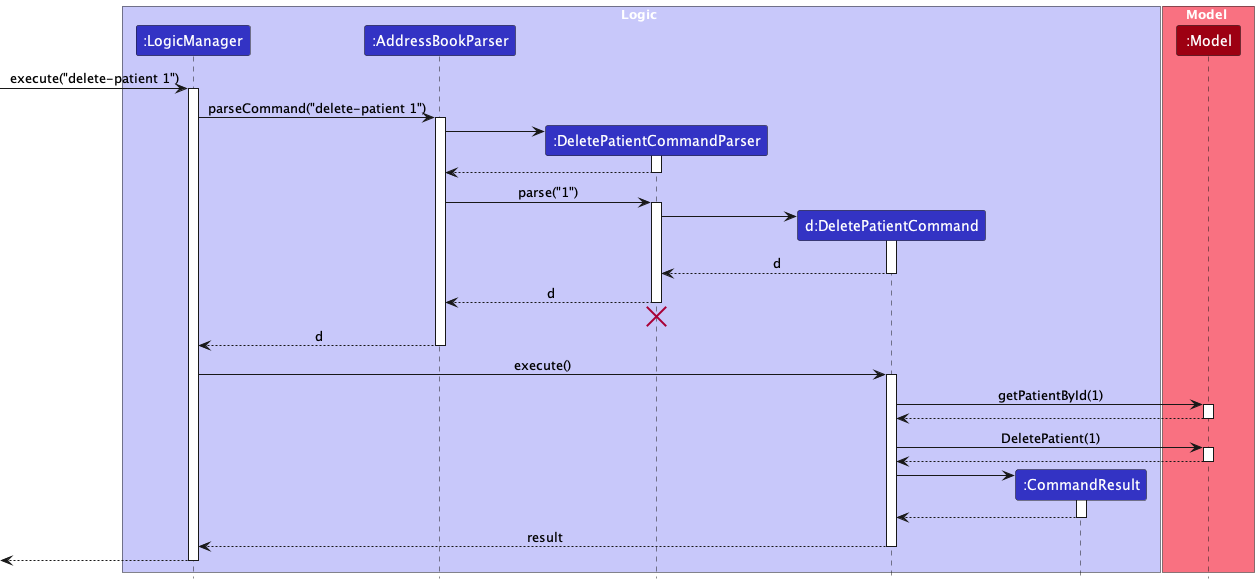
DeletePatientCommandParser should end at the destroy marker (X) but due to the limitation of PlantUML, the lifeline reaches the end of diagram.
Here are the other classes in Logic (omitted from the class diagram above) that are used for parsing a user command:

How the parsing works:
- When called upon to parse a user command, the
AddressBookParserclass creates anXYZCommandParser(XYZis a placeholder for the specific command name e.g.,AddPatientCommandParser) which uses the other classes shown above to parse the user command and create aXYZCommandobject (e.g.,AddPatientCommand) which theAddressBookParserreturns back as aCommandobject. - All
XYZCommandParserclasses (e.g.,AddPatientCommandParser,DeletePatientCommandParser, …) inherit from theParserinterface so that they can be treated similarly where possible e.g, during testing.
Model component
API : Model.java
![]()
The Model component,
- stores the ToothTracker address book data i.e., all
Patient,Dentist,Appointment, andTreatmentobjects (which are contained in aUniquePatientList,UniqueDentistList,UniqueAppointmentList, andUniqueTreatmentListobjects respectively). - stores the currently ‘selected’
Patient,Dentist, orAppointmentobjects (e.g., results of asearch-patient,search-dentist, orfilter-appointment) as corresponding separate filtered lists which are exposed to outsiders as unmodifiableObservableList<Patient>,ObservableList<Dentist>andObservable<Appointment>that can be ‘observed’ e.g. the UI can be bound to these lists so that the UI automatically updates when the data in the lists change. - stores a
UserPrefobject that represents the user’s preferences. This is exposed to the outside as aReadOnlyUserPrefobject. - does not depend on any of the other three components (as the
Modelrepresents data entities of the domain, they should make sense on their own without depending on other components).
Storage component
API : Storage.java
![]()
The Storage component,
- can save both address book data and user preference data in JSON format, and read them back into corresponding objects.
- inherits from both
AddressBookStorageandUserPrefStorage, which means it can be treated as either one (if only the functionality of only one is needed). - depends on some classes in the
Modelcomponent (because theStoragecomponent’s job is to save/retrieve objects that belong to theModel)
Common classes
Classes used by multiple components are in the seedu.addressbook.commons package.
API : Commons
Implementation
This section describes some noteworthy details on how certain features are implemented.
The features implemented are categorized into 5 sections:
Dentist Features
Adding a Dentist
The add-dentist command creates a new dentist record in ToothTracker. This command forms the fundamental business logic to represent dentists.
The activity diagram for creating a new dentist is illustrated as follows:
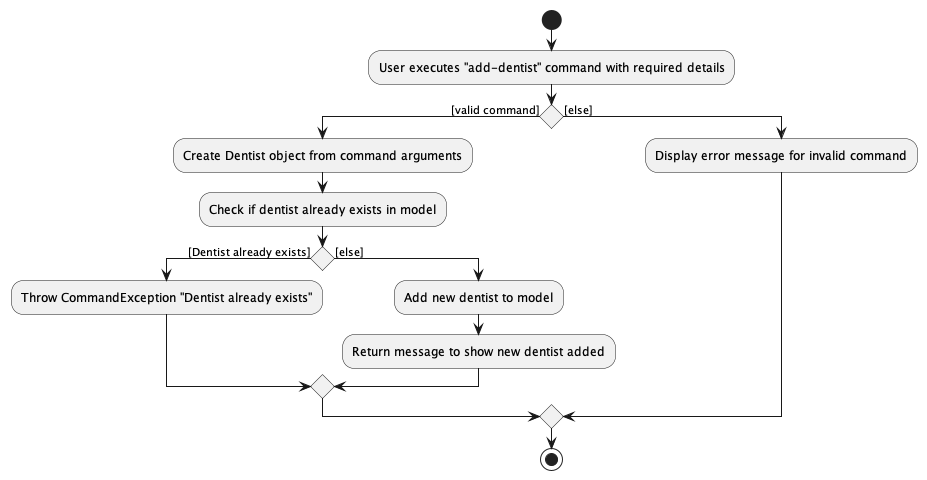
This sequence diagram shows the interactions between the various components during the execution of the add-dentist command:

Feature Details
- Users provide essential dentist information, such as their name, phone number, specialization, years of experience and other optional details like email, address and tags.
- In case of missing or invalid command arguments, the system prompts users with an error message to enter the command correctly.
- The system cross-references the new dentist’s name with existing records in the
Modelto prevent duplicate entries. If a duplicate is found, an error message informs the user. - If step 3 is completed without any exceptions, the new patient record is created and stored in the system.
Feature Considerations
For dentist specialization, broader terms like “orthodontics” are used instead of specifying the exact type of treatment (e.g., root canal, braces, scaling). This approach prevents the “add-dentist” command from becoming excessively long.
The working hours of a dentist is not an attribute in the add-dentist command as dentists might not immediately know their
shifts when they first join, and it might change frequently.
We handle duplicates by not allowing multiple dentists of the same name to be created (eg. only 1 John Tan can exist in ToothTracker). We will allow multiple dentists of the same name to be created in future implementations. For now, if there are multiple dentists with the same name, add in additional information such as their last 3 digits of NRIC as part of their name attribute.
Deleting a Dentist
The delete-dentist command deletes a dentist record in ToothTracker. This command forms the fundamental business logic to represent dentists.
The activity diagram for deleting a dentist is illustrated as follows:
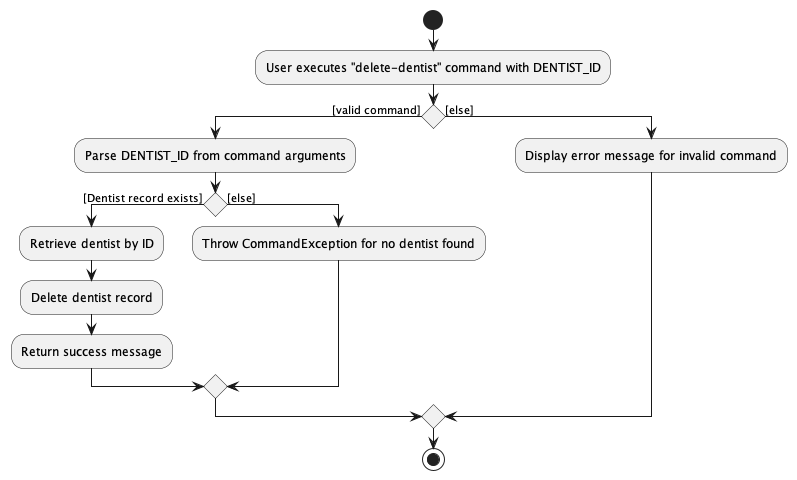
This sequence diagram shows the interactions between the various components during the execution of the delete-dentist command:
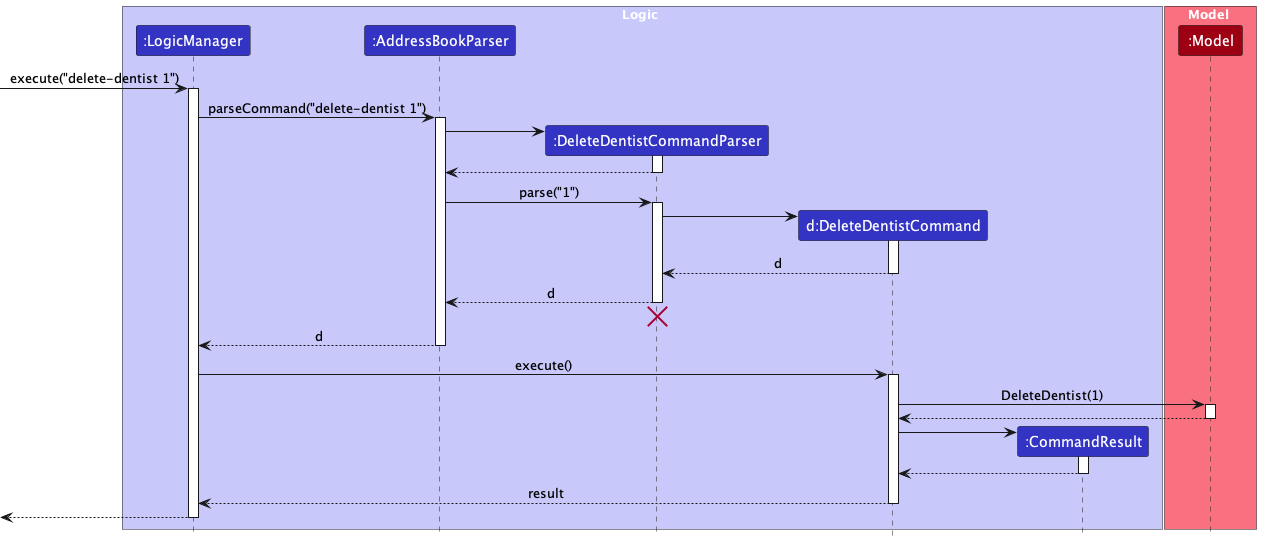
Feature Details
- The user specifies a
DENTIST_IDthat represents aDentistto be edited. - If an invalid
DENTIST_IDis provided, an error is thrown and the user is prompted to enter the command correctly via an error message. - The Dentist is cross-referenced in the
Modelto check if it exists. If it does not, then an error is raised to inform the user. - If step 3 completes without any exceptions, then the
Dentistis successfully deleted.
Feature Considerations
In implementing the delete feature, we needed proper error handling and validation to ensure ToothTracker’s robustness and provide clear guidance to the user.
Our approach validates the DENTIST_ID and shows an error message if the dentist does not exist.
This is in comparison to allowing commands to fail silently if the dentist specified does not exist.
- Pros: Prevents invalid operations and provides immediate feedback to the user, helping to correct mistakes.
- Cons: Additional validation checks add complexity to the code.
Searching for a dentist
The search-dentist command finds dentist records in ToothTracker by allowing users to enter a specific DENTIST_ID or
name-related keywords.
The activity diagram for searching for a dentist is illustrated as follows:
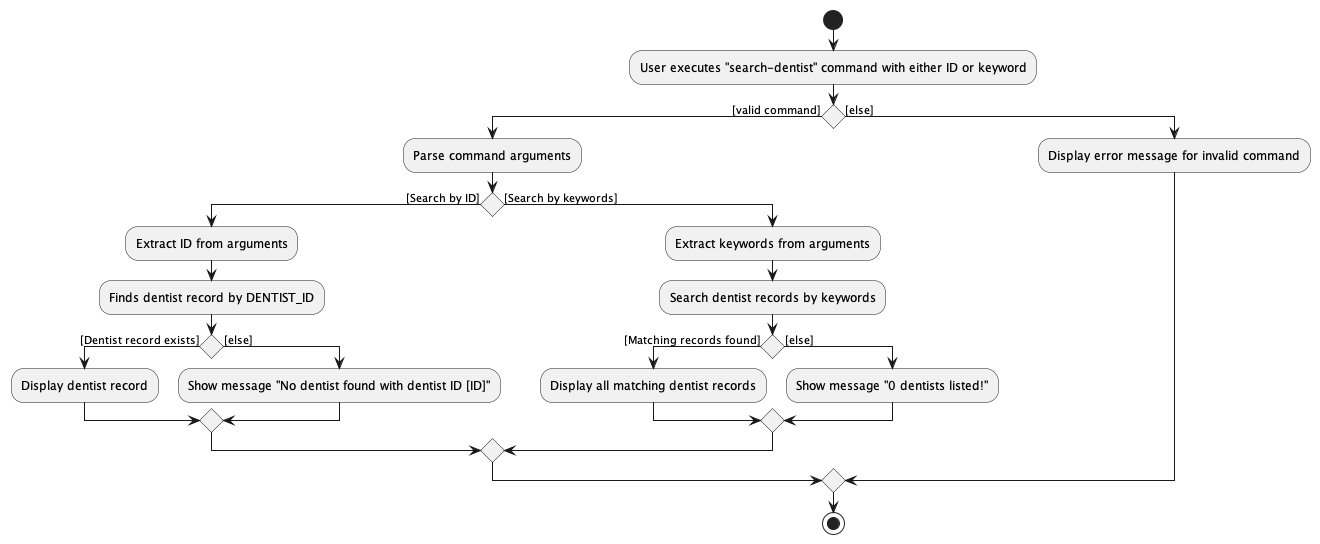
This sequence diagram shows the interactions between the various components during the execution of the search-dentist command:
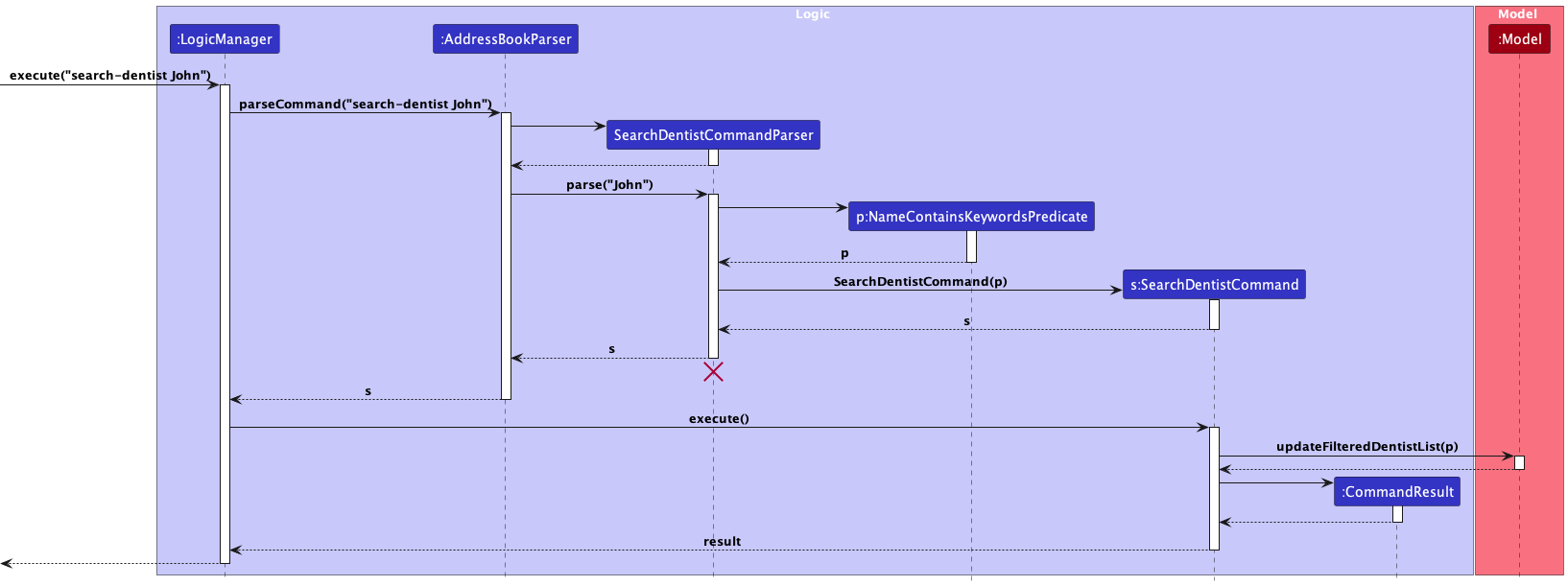
Feature Details
- Users initiate a search for a dentist using either a unique
DENTIST_IDor by inputting specificKEYWORDSthat might match a dentist’s name. - If the user opts for an ID-based search, the system processes the request to return a single record that matches the provided
DENTIST_ID. - If keywords are used, the system performs a broader search by comparing the keywords as substrings with the names in the dentist records.
- In scenarios where the search criteria do not correspond with any existing records (either no matching ID or keywords), the system generates an error message informing the user of the unsuccessful search attempt.
- When matches are found, the system displays a list of dentists whose records meet the search criteria.
Feature Considerations
The search-dentist feature in ToothTracker focuses on searching using either a unique DENTIST_ID or keywords matching a dentist’s name,
prioritizing speed and simplicity in accessing dentist records. For more complex searching which requires additional dentist attributes, users
are recommended to use the filter-dentist command instead. This approach ensures a balanced functionality within ToothTracker, offering a balance
between quick searches for immediate needs while also accommodating more complex and attribute-specific inquiries.
Filtering a dentist
The filter-dentist command in ToothTracker provides users with a more refined search functionality, allowing them to filter dentist records based on
specific criteria beyond just DENTIST_ID or name-related keywords. This feature offers a versatile and detailed search capability for users who
require precise results from the dentist records database.
The activity diagram for filtering dentists is illustrated as follows:
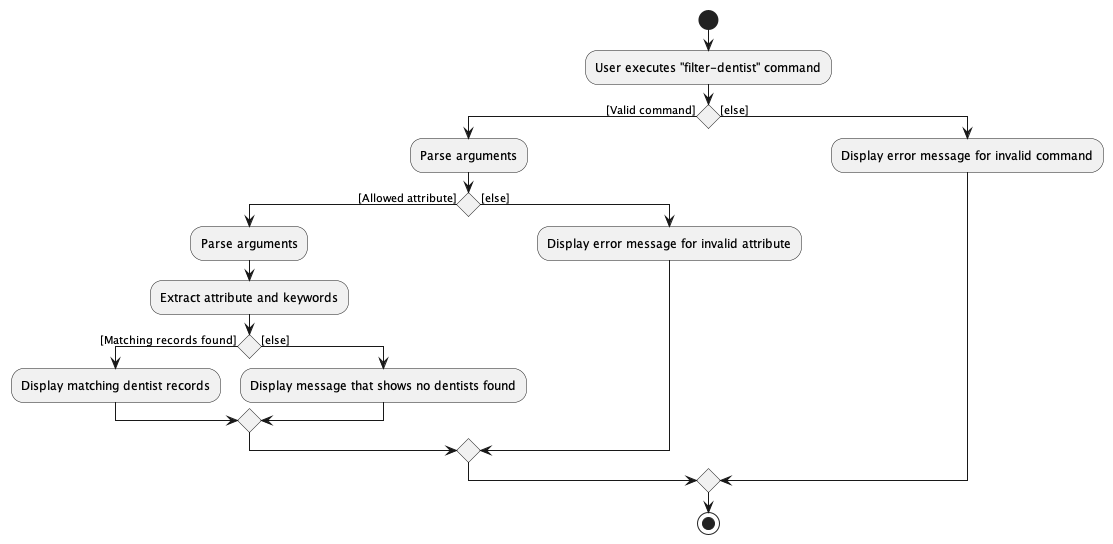
This sequence diagram shows the interactions between the various components during the execution of the filter-dentist command:

Feature Details
- Users initiate a filter for a dentist by providing various filter criteria such as SPECIALIZATION, EXPERIENCE, TAGS, and more. These criteria allow users to search for dentists with specific attributes.
- ToothTracker processes the user’s filter criteria and matches them against the dentist records in the database.
- Dentists that meet the filter criteria are displayed as search results, providing users with a list of dentists that fulfill their specific requirements.
- If no matches are found for the given filter criteria, the system informs the user that no results were found based on the specified filters.
Feature Considerations
The filter-dentist feature in ToothTracker is tailored for users who require precise control over their dentist searches. Unlike the search-dentist command,
which primarily relies on DENTIST_ID and name-related keywords, the filter-dentist command operates by filtering based on specific attributes within a dentist’s record.
To ensure the validity of the filter criteria, the filter-dentist command conducts validation checks to confirm that the selected attribute for filtering is a valid attribute
associated with a dentist’s record.
While the filter-dentist command contains validation checks if the attribute to filter by is valid, it is important to note that there is no validation checks within each attribute to verify whether the entered
keyword is of a valid type for that particular attribute. Users are responsible for inputting keywords that are meaningful and applicable to the chosen attribute.
Patient Features
Adding a Patient
The add-patient command creates a new patient record in ToothTracker. This command forms the fundamental business logic to represent patients.
The activity diagram for creating a new patient is illustrated as follows:
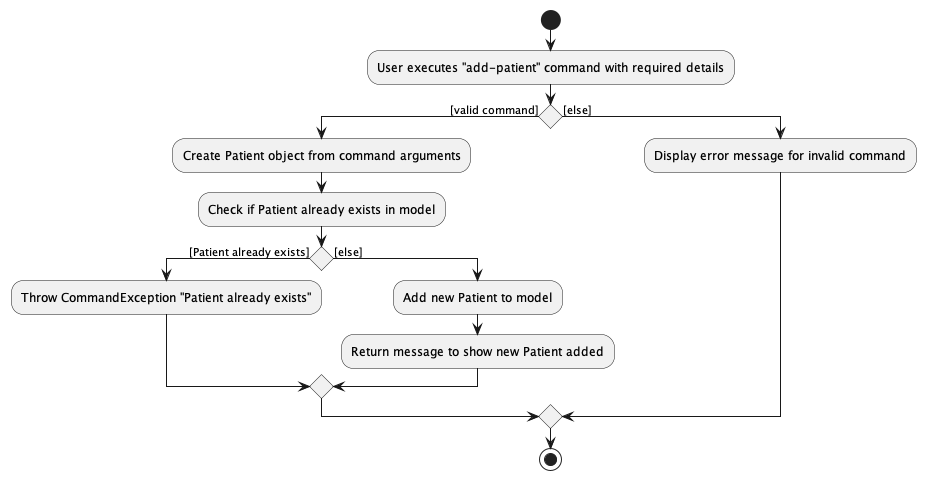
This sequence diagram shows the interactions between the various components during the execution of the add-patient command:

Feature Details
- Users provide essential patient information, such as their name, phone number, birth date, gender and other optional details like remark, treatment, email and address.
- In case of missing or invalid command arguments, the system prompts users with an error message to enter the command correctly.
- The system cross-references the new patient’s name with existing records in the
Modelto prevent duplicate entries. If a duplicate is found, an error message informs the user. - If step 3 is completed without any exceptions, the new patient record is created and stored in the system.
Feature Considerations
For the optional Treatment field, should the user opt to enter a treatment, it is mandatory that the specified treatment already exists within ToothTracker. If this condition is not met (the treatment specified does not exist in ToothTracker), the user will receive an error message.
Deleting a Patient
The delete-patient command deletes a patient record in ToothTracker. This command forms the fundamental business logic to represent patients.
The activity diagram for deleting a patient is illustrated as follows:
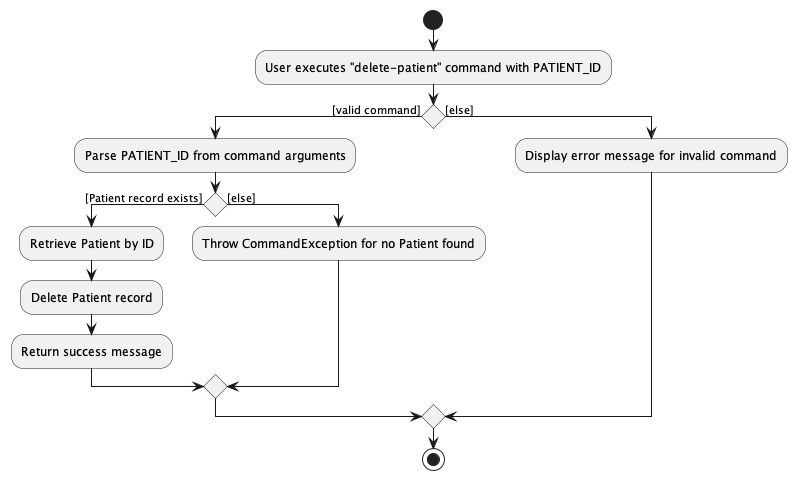
This sequence diagram shows the interactions between the various components during the execution of the delete-patient command:

Feature Details
- The user specifies a
PATIENT_IDthat represents aPatientto be edited. - If an invalid
PATIENT_IDis provided, an error is thrown and the user is prompted to enter the command correctly via an error message. - The Patient is cross-referenced in the
Modelto check if it exists. If it does not, then an error is raised to inform the user. - If step 3 completes without any exceptions, then the
Patientis successfully deleted.
Feature Considerations
In implementing the delete feature, we needed proper error handling and validation to ensure ToothTracker’s robustness and provide clear guidance to the user.
Our approach validates the PATIENT_ID and shows an error message if the patient does not exist.
This is in comparison to allowing commands to fail silently if the patient specified does not exist.
- Pros: Prevents invalid operations and provides immediate feedback to the user, helping to correct mistakes.
- Cons: Additional validation checks add complexity to the code.
Searching for a patient
The search-patient command finds patient records in ToothTracker by allowing users to enter a specific PATIENT_ID or
name-related keywords.
The activity diagram for searching for a patient is illustrated as follows:
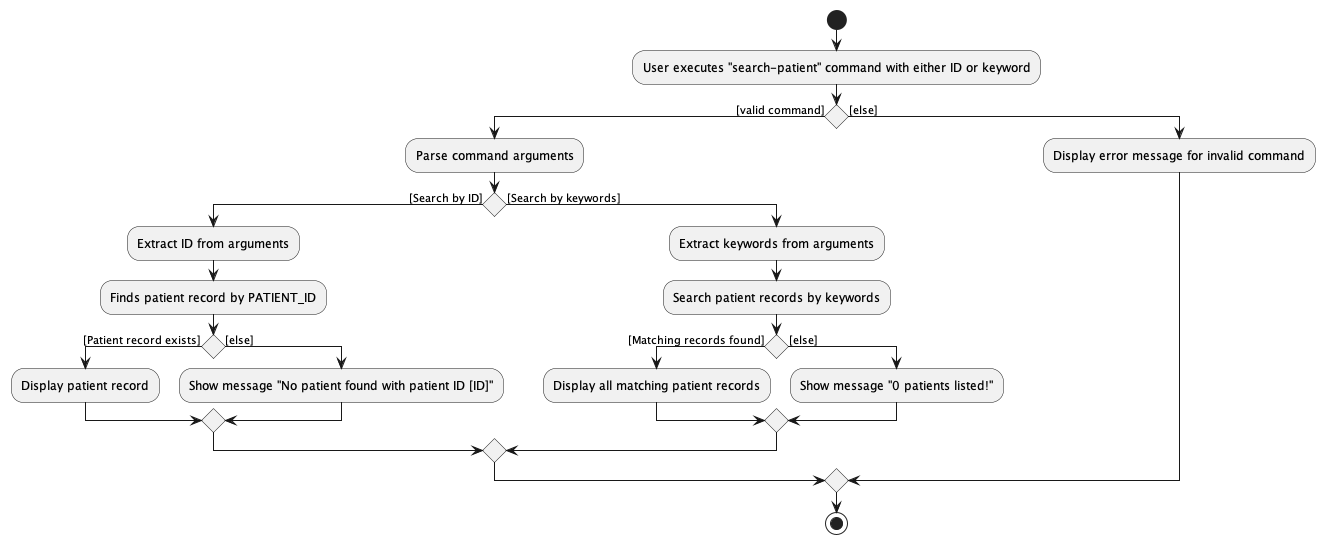
This sequence diagram shows the interactions between the various components during the execution of the search-patient command:
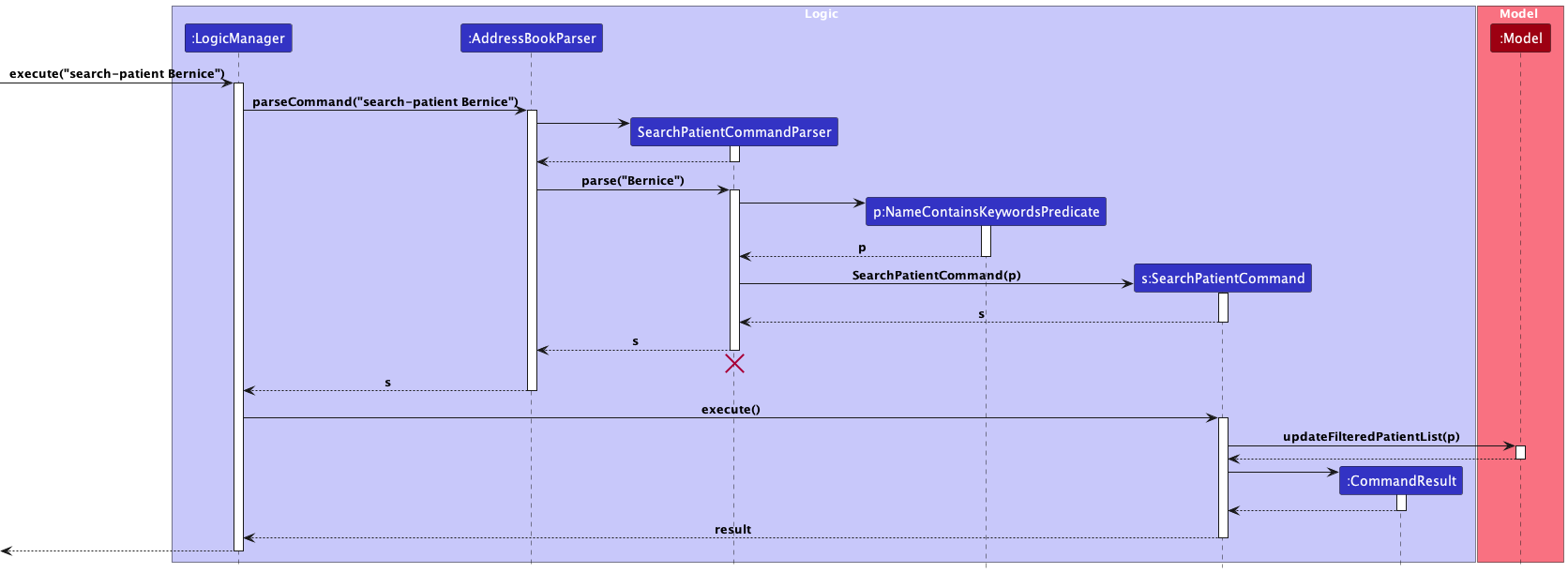
Feature Details
- Users initiate a search for a patient using either a unique
PATIENT_IDor by inputting specificKEYWORDSthat might match a patient’s name. - If the user opts for an ID-based search, the system processes the request to return a single record that matches the provided
PATIENT_ID. - If keywords are used, the system performs a broader search by comparing the keywords as substrings with the names in the patient records.
- In scenarios where the search criteria do not correspond with any existing records (either no matching ID or keywords), the system generates an error message informing the user of the unsuccessful search attempt.
- When matches are found, the system displays a list of patients whose records meet the search criteria.
Feature Considerations
The search-patient feature in ToothTracker focuses on searching using either a unique PATIENT_ID or keywords matching a patient’s name,
prioritizing speed and simplicity in accessing patient records. For more complex searching which requires additional patient attributes, users
are recommended to use the filter-patient command instead. This approach ensures a balanced functionality within ToothTracker, offering a balance
between quick searches for immediate needs while also accommodating more complex and attribute-specific inquiries.
Filtering a patient
The filter-patient command in ToothTracker provides users with a more refined search functionality, allowing them to filter patient records based on
specific criteria beyond just PATIENT_ID or name-related keywords. This feature offers a versatile and detailed search capability for users who
require precise results from the patient records database.
The activity diagram for filtering patients is illustrated as follows:
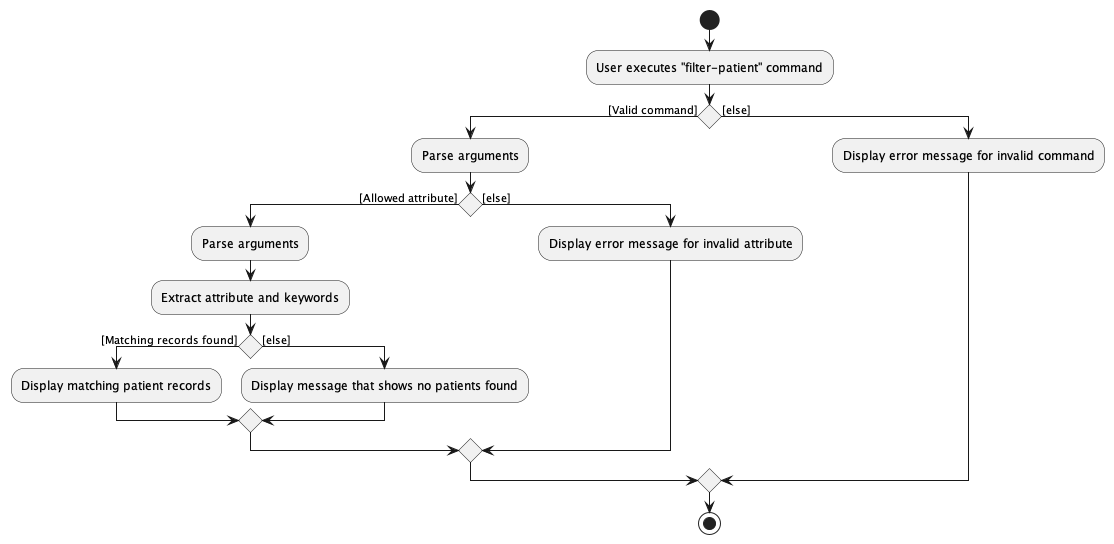
This sequence diagram shows the interactions between the various components during the execution of the filter-patient command:

Feature Details
- Users initiate a filter for a patient by providing various filter criteria such as PHONE, ADDRESS, GENDER, TREATMENT and more. These criteria allow users to search for patients with specific attributes.
- ToothTracker processes the user’s filter criteria and matches them against the patient records in the database.
- Patients that meet the filter criteria are displayed as search results, providing users with a list of patients that fulfill their specific requirements.
- If no matches are found for the given filter criteria, the system informs the user that no results were found based on the specified filters.
Feature Considerations
The filter-patient feature in ToothTracker is tailored for users who require precise control over their patient searches. Unlike the search-patient command,
which primarily relies on PATIENT_ID and name-related keywords, the filter-patient command operates by filtering based on specific attributes within a patient’s record.
To ensure the validity of the filter criteria, the filter-patient command conducts validation checks to confirm that the selected attribute for filtering is a valid attribute
associated with a patient’s record.
While the filter-patient command contains validation checks if the attribute to filter by is valid, it is important to note that there is no validation checks within each attribute to verify whether the entered
keyword is of a valid type for that particular attribute. Users are responsible for inputting keywords that are meaningful and applicable to the chosen attribute.
Appointment Features
Adding an Appointment
The add-appointment command creates a new appointment record in ToothTracker.
The activity diagram for creating a new appointment is illustrated as follows:
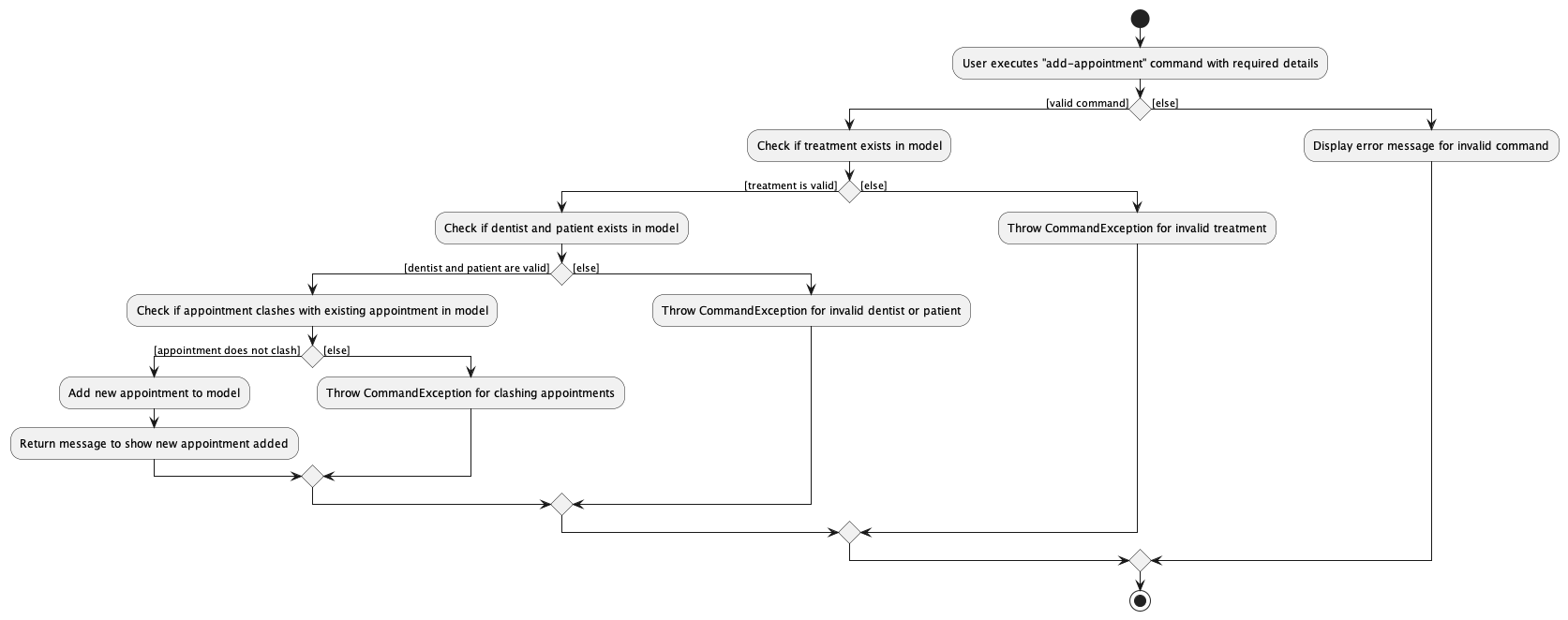
The sequence diagram shows the interactions between the various components during the execution of the add-appointment command:

Feature Details
- Users provide essential appointment information, such as the
DENTIST_ID,PATIENT_ID, appointment start time and treatment name. - In case of missing or invalid command arguments, the system prompts users with an error message to enter the command correctly.
- The system retrieves information about the treatment cost, duration, dentist and patient from the
Modelusing the information provided by the user. - The system checks the new appointment’s time slot with existing appointments in the
Modelto prevent clashing appointments. If a timing clash is found, an error message informs the user. - If step 4 is completed without any exceptions, the new appointment record is created and stored in the system.
Feature Considerations
For the DENTIST_ID, PATIENT_ID and treatment field, it is mandatory that the specified dentist, patient and treatment exists in ToothTracker.
If these conditions are not met, the user will receive an error message.
Users should use the command list-appointment first before adding an appointment due to the way add-appointment is implemented.
When adding an appointment, the list of appointments might get filtered if the new appointment clashes with existing
ones due to the check for clashes. The filtered list will remain until list-appointment is called.
Thus, if a new appointment is immediately added after this, the new appointment may not show up on the list of
appointments in the UI. Users would have to use list-appointment to view the newly added appointment on the list.
After adding an appointment, the details of the appointment can no longer be changed even if the details of the dentist, patient or treatment are changed as we did not implement cascading. Users would have to delete the appointment and add a new one if they wish to change the details of the appointment.
Deleting an Appointment
The delete-appointment command deletes an appointment record from ToothTracker.
The activity diagram for deleting an appointment is illustrated as follows:
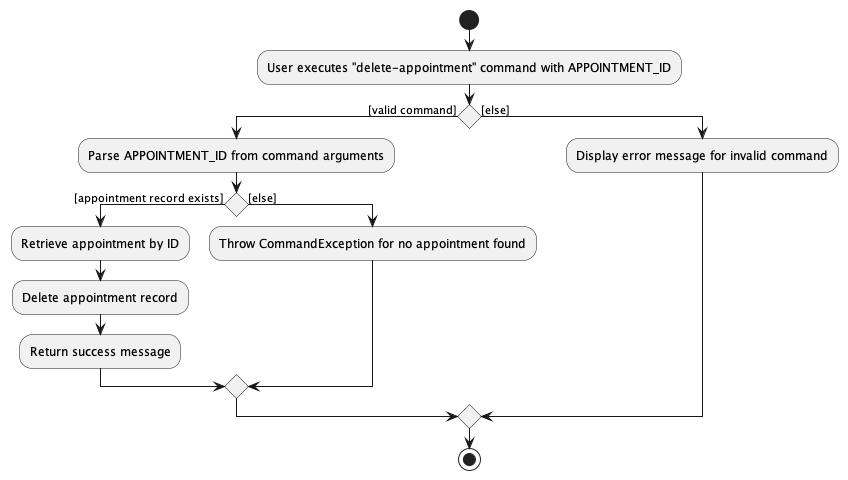
The sequence diagram shows the interactions between the various components during the execution of the delete-appointment command:
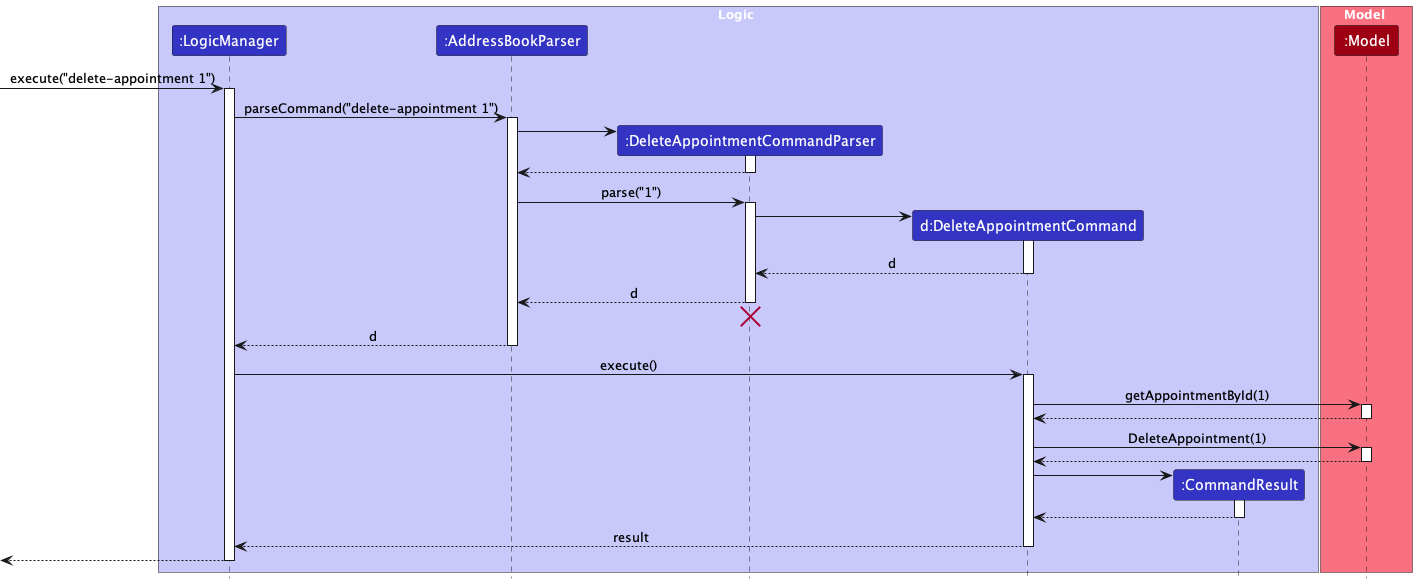
Feature Details
- The user specifies an
APPOINTMENT_IDthat represents anAppointmentto be deleted. - If an invalid
APPOINTMENT_IDis provided, an error is thrown and the user is prompted to enter the command correctly via an error message. - The Appointment is cross-referenced in the
Modelto check if it exists. If it does not, then an error is raised to inform the user. - If step 3 completes without any exceptions, then the
Appointmentis successfully deleted.
Feature Considerations
In implementing the delete-appointment feature, we needed proper error handling and validation to ensure ToothTracker’s robustness and provide clear guidance to the user.
Our approach validates APPOINTMENT_ID and shows an error message if the appointment does not exist.
This is in comparison to allowing commands to fail silently if an appointment does not exist.
- Pros: Prevents invalid operations and provides immediate feedback to the user, helping to correct mistakes.
- Cons: Additional validation checks add complexity to the code.
Filtering an Appointment
The filter-appointment command filters appointments by DENTIST_ID or PATIENT_ID.
The activity diagram for filtering an appointment is illustrated as follows:
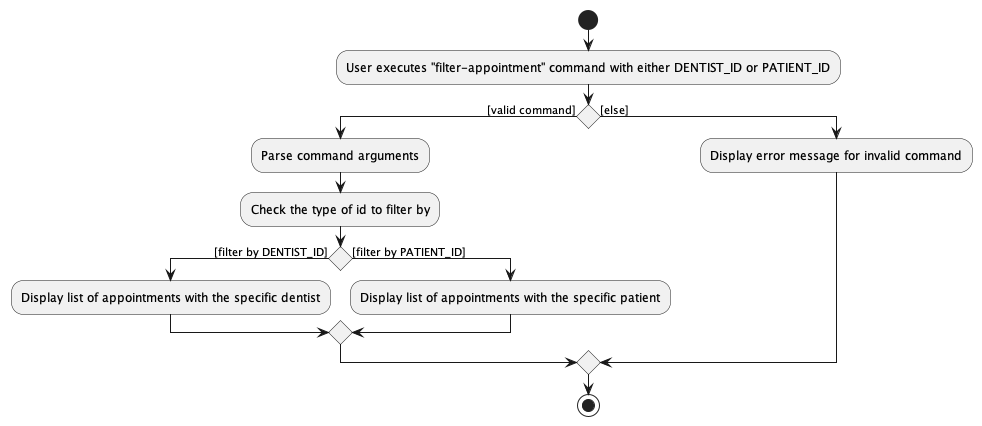
The sequence diagram shows the interactions between the various components during the execution of the filter-appointment command:
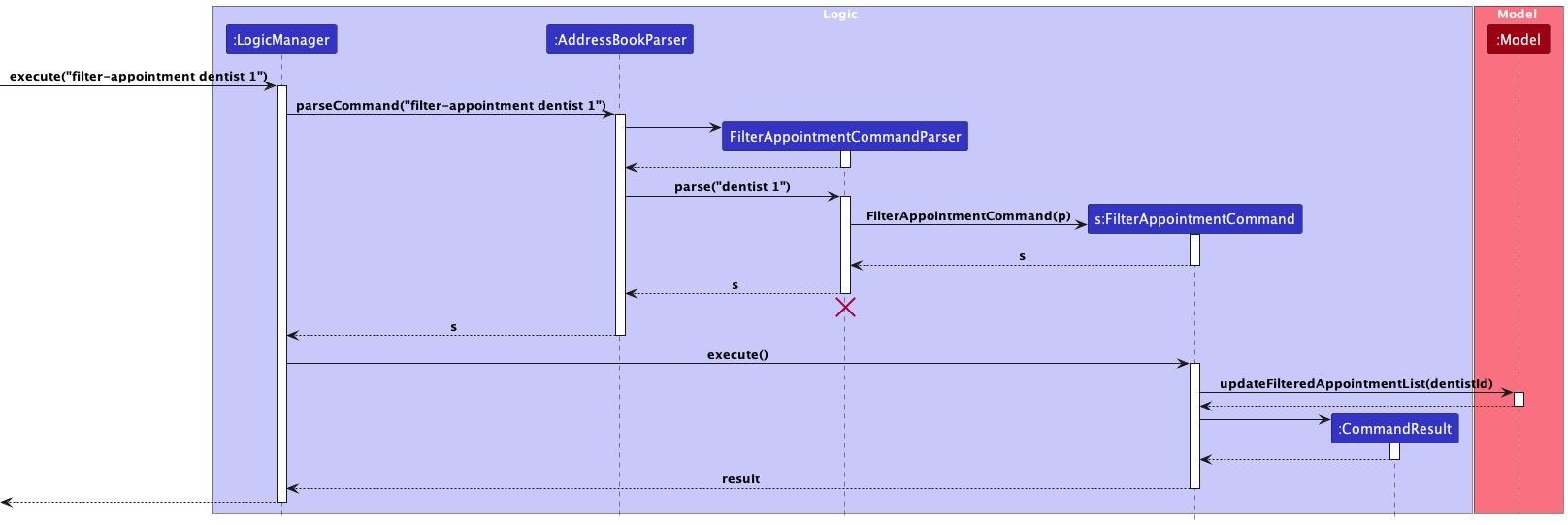
Feature Details
- Users initiate a filter for appointments using either a unique
DENTIST_IDor a uniquePATIENT_ID. - If an invalid
DENTIST_IDorPATIENT_IDis provided, an error is thrown and the user is prompted to enter the command correctly via an error message. - If the user opts to filter by
DENTIST_ID, the system processes the request to return a list of appointments with the specific dentist. - If the user opts to filter by
PATIENT_ID, the system processes the request to return a list of appointments with the specific patient. - If there are no appointments with the specific dentist or patient, the system informs the user that no appointments were found with the specific dentist or patient.
Feature Considerations
Validation checks are performed to ensure that the DENTIST_ID or PATIENT_ID is valid and is clearly stated.
Otherwise, the user would receive an error message that prompts them to input the correct command and details.
If no appointments with the specified dentist or patient are found in ToothTracker, it should be clearly
communicated to the user instead of just displaying an empty list. A message stating that no appointments are found with the
specified DENTIST_ID or PATIENT_ID should be displayed to the user.
Listing all Appointments
The list-appointment command lists all appointment records saved in ToothTracker.
Feature Details
- Users would key in
list-appointment. - All appointment records saved in ToothTracker would be displayed in the appointment list area.
Feature Considerations
Since filter-appointment and add-appointment may alter the appointment list displayed, we implemented
list-appointment so that users can view all the appointments saved in ToothTracker.
Treatment Features
Adding a Treatment
The add-treatment command creates a new treatment record in ToothTracker.
The activity diagram for creating a new treatment is illustrated as follows:
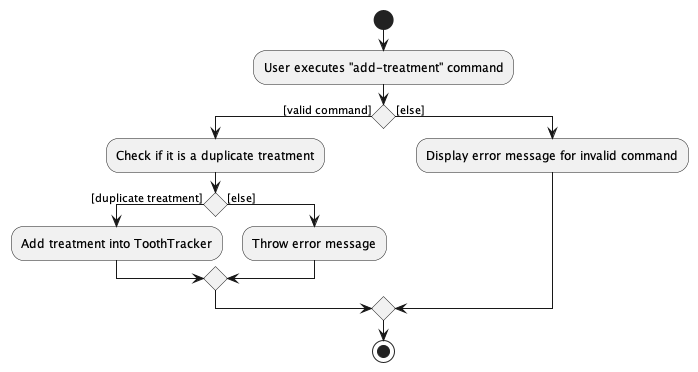
The sequence diagram of the add-treatment command:
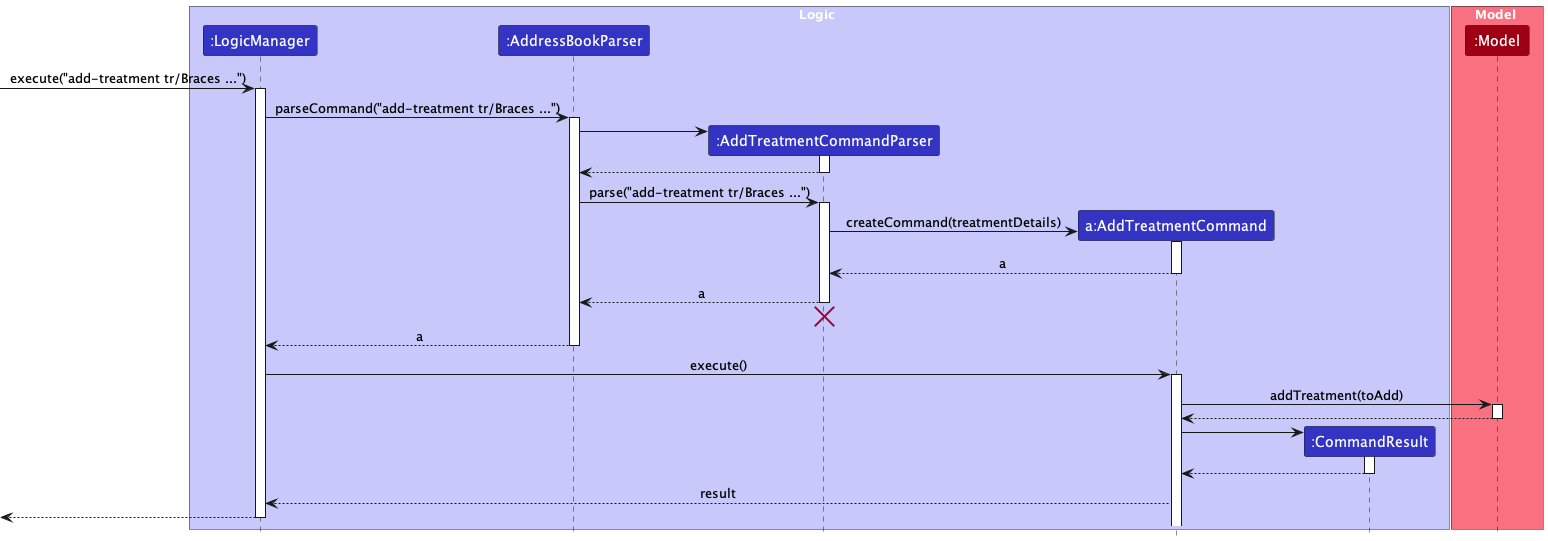
Feature Details
- Users would key in the available treatments in their clinic, specifying the treatment name, cost and its duration.
- In the event of missing or invalid command arguments, the system prompts users with an error message to enter the command correctly.
- The system cross-references the new treatment name with existing records in the
Modelto prevent duplicate entries. If a duplicate is found, an error message informs the user. - If step 3 is completed without any exceptions, the new treatment record is created and stored in the system.
Listing a Treatment
The list-treatment command would list all treatments recorded in ToothTracker.
Feature Details
- Users would key in
list-treatment. - All available treatments would be listed in the command box.
- In the event that there are no treatments, ToothTracker would display a message in the command box.
Feature Considerations
To optimize the user interface within the limited space constraints of ToothTracker, we have chosen to only display the treatment names to the user. While it would be ideal to present the cost and duration of each treatment directly, this can easily lead to clutter within ToothTracker.
To address this problem, we will consider implementing a separate window in future implementations that provides a comprehensive overview of all available treatments, along with their respective costs and durations. This additional window will ensure that users can still access detailed information without overwhelming the main interface. By doing so, we maintain a clean and user-friendly design while offering detailed information regarding treatment types.
Deleting a Treatment
The delete-treatment command deletes a treatment record in ToothTracker.
The activity diagram for deleting a treatment is illustrated as follows:
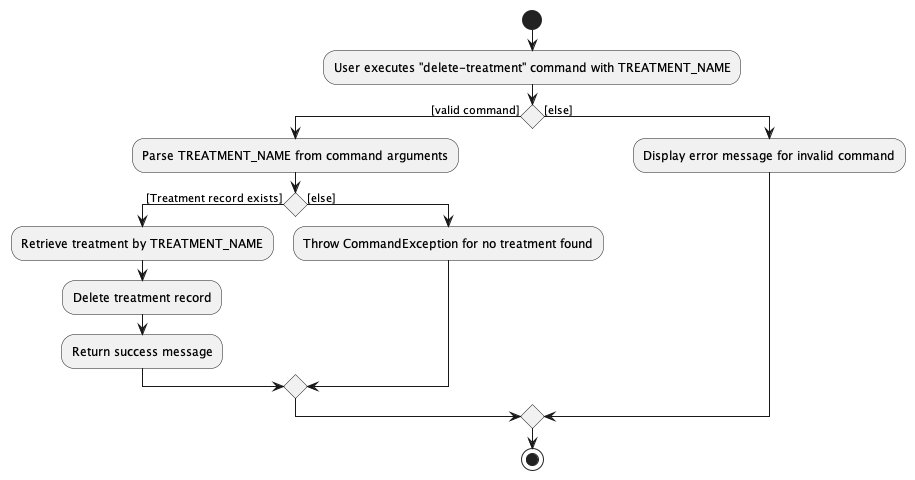
This sequence diagram shows the interactions between the various components during the execution of the delete-treatment command:
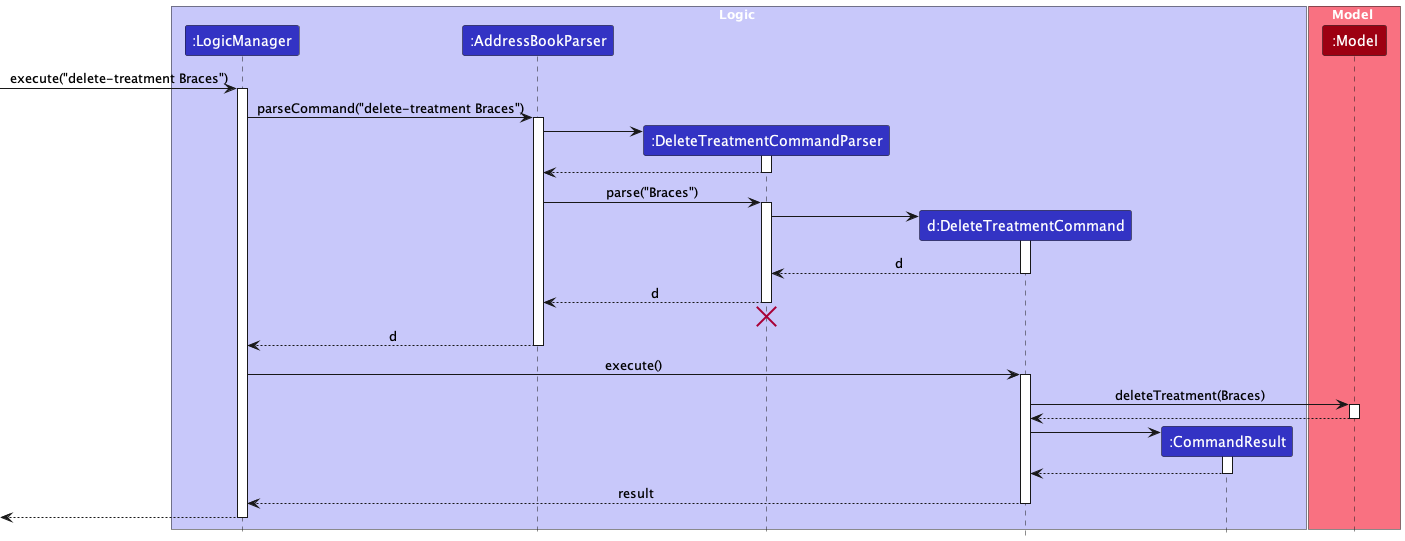
General Features
Exit ToothTracker
The exit command is used to close or exit the ToothTracker application. This command provides a way to leave the application.
Clear
The clear command is used to refresh the display within ToothTracker. It removes any unnecessary information from the command box, providing a clean slate for a better user experience.
Help
The help command is used to access a guide or information on available commands and their usage within ToothTracker. This command serves as a quick reference to assist users in navigating the application.
Future Implementation
Filter Feature Enhancement
Overview
As a future improvement to the filter feature, we are considering implementing validation for keyword arguments to ensure that they are valid for the specified attribute. This enhancement aims to provide a more robust and user-friendly filtering mechanism, preventing the use of irrelevant or incorrect keywords.
Validation of Keywords
Currently, the filter feature checks the validity of the attribute to filter by but does not validate the keywords provided. For instance, if filtering by the attribute “birthday,” users can enter nonsensical or invalid keywords, potentially leading to undesired results.
To address this, the following steps can be taken:
-
Define Valid Keywords:
- Establish a set of valid keywords for each attribute that can be used in the filter command.
-
Keyword Validation Check:
- Modify the filter feature to validate the provided keywords against the predefined set of valid keywords for the specified attribute.
-
Informative Error Messages:
- Provide informative error messages if users attempt to filter using invalid keywords, guiding them on the correct usage.
-
User Guide Update:
- Update the User Guide to include information about valid keywords for each attribute, ensuring users are aware of the allowed values.
This enhancement contributes to the overall reliability and user experience of the filter feature, making it more robust and user-friendly.
Command History
Overview
Introduce a command history feature to enhance the user experience by allowing users to retrieve and reuse their last entered commands. This functionality is similar to the up arrow functionality in most IDEs or terminals, providing users with a convenient way to recall and execute previous commands.
Key Features
-
Command History Navigation:
- Allow users to navigate through their command history using arrow keys (up and down) within the CLI interface.
-
Display Previous Commands:
- Implement a mechanism to display a list of previous commands as the user navigates through the history. This can be shown either in-place or in a separate section of the CLI.
-
Immediate Execution:
- Enable users to immediately execute a command from the history by selecting it. This streamlined process saves time and enhances user efficiency.
-
Persistent History Across Sessions:
- Ensure that the command history is persistent across different sessions of the application, allowing users to access their command history even after closing and reopening the CLI.
-
Configurable History Size:
- Provide users with the ability to configure the size of their command history. This allows customization based on individual preferences and workflow.
Usage Example
$ user@ToothTracker:~$ [User enters a command]
$ user@ToothTracker:~$ [User presses the up arrow]
$ user@ToothTracker:~$ [Previous command from history is displayed]
$ user@ToothTracker:~$ [User presses Enter to execute the displayed command]
Benefits
-
Improved Efficiency: Users can quickly access and reuse previously entered commands, reducing the need to type repetitive commands manually.
-
User-Friendly Interaction: Enhances the overall user experience by providing a familiar and intuitive command history navigation, similar to other CLI interfaces.
List-Treatment Feature Enhancement
Overview
The current list-treatment command outputs all available treatment names in a text box due to time and UI constraints. Including additional details such as duration and cost would overcrowd the command box.
To address these limitations, a future enhancement for the list-treatment command could be the introduction of a new popup window. This window would present a table with columns for treatment name, cost, and duration when the command is entered.
Benefits
-
Improved Readability
- A table format allows users to quickly scan and compare options, making it easier to digest information at a glance. Clear separation of data into columns would significantly enhance the readability of the information.
-
Enhanced User Experience
- A popup window would declutter the main command box, leading to a cleaner and more focused user interface. This would allow users to stay in the context of the command while accessing detailed information without being overwhelmed.
Quick Notes Feature Enhancement
Overview
The current quick notes box features white as the text selection color, which causes selected text to blend into the white background, rendering it invisible. A proposed enhancement is to change the selection color to grey to maintain the visibility of the selected text.
Benefits
-
Enhanced Visibility
- Grey text selection would stand out against a white background, making it easier for users to see what text they have selected. This would prevent the problem of text ‘disappearing’ upon selection.
-
User Accessibility
- The change would be a significant improvement for users with visual impairments or those working in brightly lit environments where screen glare can make it hard to distinguish between colors with low contrast.
Appointment Name Updater
Overview
The current implementation of the appointments class stores all data as strings, leading to inconsistencies when a patient or dentist’s name is changed, as this change is not automatically reflected in existing appointments. To address this, we could implement an update script for the ‘edit-patient’ and ‘edit-dentist’ commands that would:
- Search through the list of appointments.
- Identify appointments that contain the ID of the patient or dentist whose name has been edited.
- Update the relevant name field to reflect the new name.
This enhancement would ensure that name changes are consistently carried out across all records, thereby maintaining data integrity and coherence.
Future Appointment Updater
Overview
In the current implementation of ToothTracker, the deletion of a patient or dentist does not automatically remove their association with future appointments, which leads to obsolete records. To rectify this, we could integrate a script into the delete-patient or delete-dentist command with the following steps:
- Conduct a search through the appointments list.
- Locate any future appointments linked to the ID of the patient or dentist who has been deleted.
- Proceed to remove these identified future appointments from the system.
This would ensure the automatic removal of any future appointments related to patients or dentists who have been deleted, thereby maintaining an accurate and up-to-date schedule within ToothTracker.
Documentation, logging, testing, configuration, dev-ops
Appendix: Requirements
Product scope
Target user profile: Front Desk Dental Clinic Administrative Staff who
- need to obtain patient/dentist personal details quickly
- need find out the most recent appointments
- prefer desktop apps over other types
- can type fast
- prefers typing to mouse interactions
- is reasonably comfortable using CLI apps
Value proposition: Easily obtain patient/dentist records through a CLI
User stories
Priorities: High (must have) - * * *, Medium (nice to have) - * *, Low (unlikely to have) - *
| Priority | As a … | I want to … | So that I can… |
|---|---|---|---|
* * * |
receptionist | create a new patient profile | keep track and maintain patient records |
* * * |
receptionist | create a new dentist profile | keep track and maintain dentist records |
* * * |
receptionist | delete a patient/dentist | remove individuals who are no longer associated with the clinic |
* * * |
receptionist | list all patients/dentists | view all patients/dentists in the clinic |
* * * |
receptionist | edit a dentist/patient profile | keep my records up to date |
* * * |
receptionist | search for patients by name or ID | access patient profiles quickly |
* * * |
receptionist | search for dentists by name or ID | access dentist profiles quickly |
* * * |
receptionist | filter for patients using any attributes of a patient | view all patients that match filter criteria based on specific attributes |
* * * |
receptionist | filter for dentists using any attributes of a dentist | view all dentists that match filter criteria based on specific attributes |
* * * |
receptionist | create a new treatment | record the treatment performed in an appointment |
* * * |
receptionist | list all treatments available | check what available treatments in the clinic |
* * * |
receptionist | delete a treatment | remove treatments that are no longer provided in the clinic |
* * * |
receptionist | create a new appointment | assign a patient and a dentist for an appointment |
* * * |
receptionist | list all appointments | view all appointments available in the clinic |
* * * |
receptionist | delete an appointment | remove appointments cancelled or postponed in the clinic |
* * * |
receptionist | filter for appointments using Patient ID | view all appointments that patient has in the clinic |
* * * |
receptionist | filter for appointments using Dentist ID | view all appointments that dentist has in the clinic |
* * * |
receptionist | view clinic schedule in a calendar | have an overview of the clinic’s schedules for admin management |
Use cases
(For all use cases below, the System is ToothTracker and the Actor is the user, unless specified
otherwise)
Use case: Add a Dentist
MSS
- User submits a request to create a new dentist, and provides information about the dentist.
- ToothTracker acknowledges the request to add a new dentist.
Use case ends.
Extensions
-
1a. User inputs an invalid command.
- ToothTracker identifies the command error.
- ToothTracker prompts the user to make the necessary adjustments and provide the command in the correct format.
-
Steps within 1a repeat until a valid
add-dentistcommand is provided.Use case continues from step 2.
- ToothTracker identifies the command error.
-
1b. ToothTracker finds a pre-existing dentist entry.
- ToothTracker alerts the user about the duplicate entry.
-
Steps within 1b loop until a new, unique entry is provided.
Use case continues from step 2.
Use Case: Search for a Dentist
MSS
- User submits a request to search for a dentist:
- User specifies search criteria, which can be either a
DENTIST_IDor keywords that matches the name of a dentist.
- User specifies search criteria, which can be either a
- ToothTracker searches for a dentist based on the criteria:
- If the request specifies a
DENTIST_ID:- ToothTracker looks for a dentist with the matching ID.
- If the request specifies keywords to match a dentist name:
- ToothTracker searches for a dentist with a name that matches the specified keywords.
- If the request specifies a
- ToothTracker displays the search results:
- If one or more matching dentists are found:
- ToothTracker lists the matching dentists and their details.
Use Case Ends.
- If one or more matching dentists are found:
Extensions
-
1a. User inputs an invalid command.
- ToothTracker identifies the command error.
- ToothTracker prompts the user to make the necessary adjustments and provide the command in the correct format.
-
Steps within 1a repeat until a valid
search-dentistcommand is provided.Use case continues from step 2.
- ToothTracker identifies the command error.
-
3a. The list of dentists is empty.
-
ToothTracker displays a message indicating that there are no dentists listed.
Use Case Ends.
-
-
3b. No matching dentist found.
-
ToothTracker displays a message indicating no matching dentists were found with the corresponding
DENTIST_ID.Use Case Ends.
-
Use Case: Delete a Dentist
MSS
- User submits a request to delete a dentist:
- User specifies the
DENTIST_IDto delete.
- User specifies the
-
ToothTracker searches for the dentist entry with the matching
DENTIST_ID. - ToothTracker deletes the dentist:
-
Dentist entry is removed from the database.
Use Case Ends.
-
Extensions
-
1a. User inputs an invalid command.
- ToothTracker identifies the command error.
- ToothTracker prompts the user to make the necessary adjustments and provide the command in the correct format.
-
Steps within 1a repeat until a valid
delete-dentistcommand is provided.Use case continues from step 2.
- ToothTracker identifies the command error.
-
3a. The list of dentists is empty.
-
ToothTracker displays a message indicating that there are no dentists listed.
Use Case Ends.
-
-
3b. No matching dentist found.
-
ToothTracker displays a message indicating no matching dentists were found with the corresponding
DENTIST_ID.Use Case Ends.
-
Use Case: Filter Dentist
MSS
- User submits a request to filter dentist records:
- User specifies the filter criteria, which requires a valid attribute and a keyword.
-
ToothTracker filters dentist records based on the criteria:
- ToothTracker displays the filtered results:
- If one or more matching dentists are found:
- ToothTracker lists the matching dentists and their details.
Use Case Ends.
- If one or more matching dentists are found:
Extensions
-
1a. User inputs an invalid command.
- ToothTracker identifies the command error.
- ToothTracker prompts the user to make the necessary adjustments and provide the command in the correct format.
-
Steps within 1a repeat until a valid
filter-dentistcommand is provided.Use case continues from step 2.
- ToothTracker identifies the command error.
-
1b. User inputs an invalid attribute.
- ToothTracker identifies the command error.
- ToothTracker prompts the user to make the necessary adjustments and provide a valid attribute.
-
Steps within 1b repeat until a valid attribute is provided.
Use case continues from step 2.
- ToothTracker identifies the command error.
-
3a. The list of dentists is empty.
-
ToothTracker displays a message indicating that there are no dentists listed.
Use Case Ends.
-
-
3b. No matching dentist found.
-
ToothTracker displays a message indicating no matching dentists were found with the provided keyword for the specified attribute.
Use Case Ends.
-
Use case: List Dentist Data
MSS
- User submits a request to list all dentist data.
- ToothTracker retrieves the list of all dentist data saved in the system.
-
ToothTracker displays the list of dentist data to the user.
Use Case Ends.
Extensions
-
1a. User inputs an invalid command.
- ToothTracker identifies the command error.
- ToothTracker prompts the user to make the necessary adjustments and provide the command in the correct format.
-
Steps within 1a repeat until a valid
list-dentistcommand is provided.Use case continues from step 2.
- ToothTracker identifies the command error.
-
2a. No dentist data available.
- ToothTracker checks and finds that there are no dentist records in the system.
-
ToothTracker informs the user that no dentist data is available.
Use case continues from step 2.
Use case: Add a Patient
MSS
- User submits a request to create a new patient, and provides information about the patient.
- ToothTracker acknowledges the request to add a new patient.
Use case ends.
Extensions
-
1a. User inputs an invalid command.
- ToothTracker identifies the command error.
- ToothTracker prompts the user to make the necessary adjustments and provide the command in the correct format.
-
Steps within 1a repeat until a valid
add-patientcommand is provided.Use case continues from step 2.
- ToothTracker identifies the command error.
-
1b. ToothTracker finds a pre-existing patient entry.
- ToothTracker alerts the user about the duplicate entry.
- Steps within 1b loop until a new, unique entry is provided. Use case continues from step 2.
-
1c. User inputs a treatment that does not exist in ToothTracker
- ToothTracker checks ToothTracker and finds that the treatment provided does not exist.
- ToothTracker alerts the user that the treatment is not provided in the clinic.
-
Steps within 1c loop until an existing treatment is provided.
Use case resumes from step 2.
Use Case: Search for a Patient
MSS
- User submits a request to search for a patient:
- User specifies search criteria, which can be either a
PATIENT_IDor keywords that matches the name of a patient.
- User specifies search criteria, which can be either a
- ToothTracker searches for a patient based on the criteria:
- If the request specifies a
PATIENT_ID:- ToothTracker looks for a patient with the matching ID.
- If the request specifies keywords to match a patient name:
- ToothTracker searches for a patient with a name that matches the specified keywords.
- If the request specifies a
- ToothTracker displays the search results:
- If one or more matching patients are found:
- ToothTracker lists the matching patients and their details.
Use Case Ends.
- If one or more matching patients are found:
Extensions
-
1a. User inputs an invalid command.
- ToothTracker identifies the command error.
- ToothTracker prompts the user to make the necessary adjustments and provide the command in the correct format.
-
Steps within 1a repeat until a valid
search-patientcommand is provided.Use case continues from step 2.
- ToothTracker identifies the command error.
-
3a. The list of dentists is empty.
-
ToothTracker displays a message indicating that there are no patients listed.
Use Case Ends.
-
-
3b. No matching dentist found.
-
ToothTracker displays a message indicating no matching patients were found with the corresponding
PATIENT_ID.Use Case Ends.
-
Use Case: Delete a Patient
MSS
- User submits a request to delete a patient:
- User specifies the
PATIENT_IDto delete.
- User specifies the
-
ToothTracker searches for the patient entry with the matching
PATIENT_ID. - ToothTracker deletes the patient:
-
Patient entry is removed from the database.
Use Case Ends.
-
Extensions
-
1a. User inputs an invalid command.
- ToothTracker identifies the command error.
- ToothTracker prompts the user to make the necessary adjustments and provide the command in the correct format.
-
Steps within 1a repeat until a valid
delete-patientcommand is provided.Use case continues from step 2.
- ToothTracker identifies the command error.
-
3a. The list of patients is empty.
-
ToothTracker displays a message indicating that there are no patients listed.
Use Case Ends.
-
-
3b. No matching patient found.
-
ToothTracker displays a message indicating no matching patients were found with the corresponding
PATIENT_ID.Use Case Ends.
-
Use Case: Filter Patient
MSS
- User submits a request to filter patient records:
- User specifies the filter criteria, which requires a valid attribute and a keyword.
-
ToothTracker filters patient records based on the criteria:
- ToothTracker displays the filtered results:
- If one or more matching patients are found:
- ToothTracker lists the matching patients and their details.
Use Case Ends.
- If one or more matching patients are found:
Extensions
-
1a. User inputs an invalid command.
- ToothTracker identifies the command error.
- ToothTracker prompts the user to make the necessary adjustments and provide the command in the correct format.
-
Steps within 1a repeat until a valid
filter-patientcommand is provided.Use case continues from step 2.
- ToothTracker identifies the command error.
-
1b. User inputs an invalid attribute.
- ToothTracker identifies the command error.
- ToothTracker prompts the user to make the necessary adjustments and provide a valid attribute.
-
Steps within 1b repeat until a valid attribute is provided.
Use case continues from step 2.
- ToothTracker identifies the command error.
-
3a. The list of patients is empty.
-
ToothTracker displays a message indicating that there are no patients listed.
Use Case Ends.
-
-
3b. No matching patients found.
-
ToothTracker displays a message indicating no matching patients were found with the provided keyword for the specified attribute.
Use Case Ends.
-
Use case: List Patient Data
MSS
- User submits a request to list all patient data.
- ToothTracker retrieves the list of all patient data saved in the system.
-
ToothTracker displays the list of patients to the user.
Use case ends.
Extensions
-
1a. User inputs an invalid command.
- ToothTracker identifies the command error.
- ToothTracker prompts the user to make the necessary adjustments and provide the command in the correct format.
-
Steps within 1a repeat until a valid
list-patientcommand is provided.Use case continues from step 2.
- ToothTracker identifies the command error.
-
2a. No patient data available.
- ToothTracker checks and finds that there are no patient records in the system.
-
ToothTracker informs the user that no patient data is available.
Use case continues from step 2.
Use case: Add an Appointment
MSS
- User submits a request to add a new future appointment, providing information about the appointment.
Information includes
DENTIST_ID,PATIENT_ID, appointment start time and treatment provided during the appointment. -
ToothTracker acknowledges the request to add the new appointment.
Use case ends.
Extensions
-
1a. User inputs an invalid command.
- ToothTracker identifies the command error.
- ToothTracker prompts the user to make the necessary adjustments and provide the command in the correct format.
-
Steps within 1a repeat until a valid
add-appointmentis provided.Use case continues from step 2.
- ToothTracker identifies the command error.
-
1b. User inputs a treatment that does not exist in the database
- ToothTracker checks the database and finds that the treatment provided does not exist.
- ToothTracker alerts the user that the treatment is not provided in the clinic.
- Steps within 1b loop until an existing treatment is provided.
-
1c. User inputs a dentist or patient ID that does not exist in the database
- ToothTracker checks the database and finds that the dentist or patient ID provided does not exist.
- ToothTracker alerts the user that the patient or dentist with the provided patient or dentist ID does not exist in this clinic.
- Steps within 1c loop until valid dentist and patient IDs are provided.
-
1d. User inputs an appointment time slot that clashes with an existing one in the database
- ToothTracker checks the database and finds that the appointment to be added clashes with an existing one.
- ToothTracker alerts the user about the clashing appointments.
-
Steps within 1d loop until an appointment time slot that does not clash with an existing appointment is provided.
Use case resumes at step 1.
Use Case: Delete an Appointment
MSS
- User submits a request to delete an appointment:
- User specifies the
APPOINTMENT_IDto delete.
- User specifies the
- ToothTracker searches for the appointment entry:
- ToothTracker looks for an appointment with the matching ID.
- ToothTracker deletes the appointment:
-
Appointment entry is removed from the database.
Use Case Ends.
-
Extensions
-
2a. The list is empty.
-
ToothTracker displays a message indicating no appointments are saved in its system.
Use Case Ends.
-
-
3a. No matching appointment found.
-
ToothTracker displays an error message.
Use Case resumes at step 2.
-
-
3b. Invalid
APPOINTMENT_IDorAPPOINTMENT_IDnot found in ToothTracker.-
ToothTracker displays an error message.
Use Case ends.
-
Use case: List Appointment Data
MSS
- User submits a request to list all appointment data.
- ToothTracker retrieves the list of all appointment data saved in the system.
-
ToothTracker displays the list of appointments to the user.
Use case ends.
Extensions
-
1a. User inputs an invalid command.
- ToothTracker identifies the command error.
- ToothTracker prompts the user to make the necessary adjustments and provide the command in the correct format.
-
Steps within 1a repeat until a valid
list-appointmentcommand is provided.Use case continues from step 2.
- ToothTracker identifies the command error.
-
2a. No appointment data available.
- ToothTracker checks and finds that there are no appointment records in the system.
-
ToothTracker informs the user that no appointment data is available.
Use case continues from step 2.
Use Case: Filter Appointments
MSS
- User submits a request to filter appointments:
- User specifies filter criteria, which can be either a dentist ID [DENTIST ID] or a patient ID [PATIENT ID].
- ToothTracker filters appointment list based on the criteria:
- If the request specifies [DENTIST ID]:
- ToothTracker filters the appointment list by the specified dentist ID.
- If the request specifies [PATIENT ID]:
- ToothTracker filters the appointment list by the specified patient ID.
- If the request specifies [DENTIST ID]:
- ToothTracker displays the filter results:
- ToothTracker lists the matching appointments and their details.
Use Case Ends.
Extensions
- 2a. The list of appointment is empty:
-
ToothTracker displays a message indicating that no appointments are saved in its system.
Use Case Ends.
-
- 3a. No matching appointments found:
-
ToothTracker displays a message indicating no matching appointments were found.
Use Case Ends.
-
- 3b. Invalid appointment ID:
-
ToothTracker displays an error message.
Use Case Ends.
-
Use case: Add Treatment
MSS
- User submits a request to add a new type of dental treatment, providing information about the treatment name and its cost.
-
ToothTracker acknowledges the request to add the new treatment.
Use case ends.
Extensions
-
1a. User inputs an invalid command.
- ToothTracker identifies the command error.
- ToothTracker prompts the user to make the necessary adjustments and provide the command in the correct format.
-
Steps within 1a repeat until a valid
add-treatmentis provided.Use case continues from step 2.
- ToothTracker identifies the command error.
-
1b. User inputs incomplete or missing information.
- ToothTracker detects that the user did not provide all required information, such as the treatment name or cost.
-
ToothTracker prompts the user to provide both the treatment name and its cost.
Use case resumes at step 1.
-
1c. User inputs an invalid cost.
- ToothTracker checks the provided cost and determines that it is not a valid numeric value.
-
ToothTracker prompts the user to provide a valid numeric value.
Use case resumes at step 1.
-
1d. Duplicate treatment name.
- ToothTracker checks the database and finds that a treatment with the same name.
- ToothTracker alerts the user about the duplicate entry.
-
Steps within 1d loop until a new, unique treatment name is provided.
Use case resumes at step 1.
Use Case: Delete a Treatment
MSS
- User submits a request to delete a treatment:
- User specifies the [treatment_name] to delete.
-
ToothTracker searches for the treatment entry.
- If a match is found, ToothTracker deletes the treatment.
- Use Case Ends.
Extensions
- 2a. No treatments match the given treatment name:
- ToothTracker displays a message indicating no treatments are available.
- Repeat step 1 till the user enters a treatment which exists.
- Use Case Ends.
Use case: List Treatment Data
MSS
- User submits a request to list all treatment data.
- ToothTracker retrieves the list of all treatments saved in the system.
-
ToothTracker displays all available treatments in the command result box.
Use case ends.
Extensions
-
1a. User inputs an invalid command.
- ToothTracker identifies the command error.
- ToothTracker prompts the user to make the necessary adjustments and provide the command in the correct format.
-
Steps within 1a repeat until a valid
list-treatmentcommand is provided.Use case continues from step 2.
- ToothTracker identifies the command error.
-
2a. No treatment data available.
- ToothTracker checks and finds that there are no treatments in the system.
-
ToothTracker informs the user that no treatments are available.
Use case continues from step 2.
Non-Functional Requirements
- Should work on any mainstream OS as long as it has Java
11or above installed. - Should be able to hold up to 1000 Dentists and 1000 Patients without any major performance issues.
- A user with above average typing speed for regular English text (i.e. not code, not system admin commands) should be able to accomplish most of the tasks faster using commands than using the mouse.
- Should not use more than 2GB of RAM
- Jar file size should not exceed 150MB
Glossary
- Mainstream OS: Windows, Linux, Unix, OS-X
- CLI: command line interface
- GUI: graphical user interface, a visual way of interacting with a computer program
- PlantUML: A tool which is used to create diagrams
- API: Application Programming Interface
- Dentist List: The list of dentists displayed in ToothTracker
- Patient List: The list of patients displayed in ToothTracker
- Appointment List: The list of appointments displayed in ToothTracker
Appendix: Instructions for manual testing
Given below are instructions to test the app manually.
Launch and shutdown
Initial launch
- Download the jar file and copy into an empty folder
- Double-click the jar file.
Expected: Shows the GUI with a set of sample patients and dentists. The window size may not be optimum. It is recommended to use ToothTracker at full screen.
Saving window preferences
- Resize the window to an optimum size. Move the window to a different location. Close the window.
- Re-launch ToothTracker by double-clicking the jar file.
Expected: The most recent window size and location is retained. - { more test cases … }
Dentist
Adding a Dentist
Adding a dentist into ToothTracker’s Dentist List.
add-dentist n/Xander Chua p/98986443 s/Endodontics y/8
Expected Output in the Dentist List: New dentist added into the Dentist List. The email and address will contain Default placeholders.
Expected Output in the Command Output Box: New dentist added message is displayed with the dentist credentials.
add-dentist n/Oliver Lim
Expected Output in the Dentist List: No new dentist added.
Expected Output in the Command Output Box: Error message for invalid command format.
Listing all Dentists
Prerequisite: There is at least 1 Dentist stored in ToothTracker
list-dentist
Expected Output in the Dentist List. All Dentists stored in ToothTracker are displayed.
Expected Output in the Command Output Box: Listed all dentists!
Editing a Dentist
Prerequisite: There is at least 1 Dentist stored in ToothTracker.
In this example, we assume there are two dentists with the following attributes:
Dentist 1
- Name:
Xavier Tan - Phone:
90895772 - Email:
xaviertan@hotmail.com - Address:
Blk 33 #11-132, Serangoon Road, S335291 - Specialization:
Endodontics - Yoe (Years of Experience):
8 - Dentist ID:
1 - Tag:
Professional
Dentist 2
- Name:
Bernard Tan - Phone:
98983492 - Email:
bernardtan@hotmail.com - Address:
No Address Provided. - Specialization:
Orthodontics - Yoe (Years of Experience):
2 - Dentist ID:
4 - Tag:
Trainee
In each of the test case below, we further assume that the state of Dentist objects are always starting from the above attributes.
edit-dentist 1 n/Xaveric Tan Ming Yuan
Expected Output in the Dentist List: The name of dentist with ID 1 is changed to Xaveric Tan Ming Yuan.
Expected Output in the Command Output Box: Dentist successfully edited message, along with the updated attributes.
edit-dentist 4 p/98984477 e/btan@yahoo.com
Expected Output in the Dentist List: The phone of the dentist with ID 4 is changed to 98984477, and the email is changed to btan@yahoo.com.
Expected Output in the Command Output Box: Similar to above.
edit-dentist 4 h/Blk 653 #03-44, Bishan Ave 4, S622653
Expected Output in the Dentist List: The address of the dentist with ID 4 is changed to Blk 653 #03-44, Bishan Ave 4, S622653.
Expected Output in the Command Output Box: Similar to above.
edit-dentist 99
Expected Output in the Dentist List: No dentist is edited.
Expected Output in the Command Output Box: Error details shown for invalid ID provided.
edit-dentist
Expected Output in the Dentist List: No dentist is edited.
Expected Output in the Command Output Box: Error details shown for invalid command format.
edit-dentist 1 n/Bernard Tan
Expected Output in the Dentist List: No dentist is edited.
Expected Output in the Command Output Box: Error details shown for attempting to edit a dentist into another existing dentist.
Searching for a Dentist by Keyword
Prerequisite: There are only two dentists named Xavier Tan and Bernard Tan stored in ToothTracker.
search-dentist Xavier
Expected Output in the Dentist List: Xavier Tan dentist is displayed.
Expected Output in the Command Output Box: 1 dentists listed!
search-dentist Bernard
Expected Output in the Dentist List: Bernard Tan dentist is displayed.
Expected Output in the Command Output Box: 1 dentists listed!
search-dentist Tan
Expected Output in the Dentist List: Xavier Tan and Bernard Tan dentists are displayed.
Expected Output in the Command Output Box: 2 dentists listed!
Searching for a dentist by Dentist ID
Prerequisite: There are only two dentists named Xavier Tan and Bernard Tan stored in ToothTracker.
Xavier Tan’s Dentist ID is 1 and Bernard Tan’s Dentist ID is 4 (Dentists with ID 2 and 3 are assumed to be removed previously).
search-dentist 1
Expected Output in the Dentist List: Xavier Tan dentist is displayed.
Expected Output in the Command Output Box: Dentist with dentist ID 1 found.
search-dentist 4
Expected Output in the Dentist List: Bernard Tan dentist is displayed.
Expected Output in the Command Output Box: 1 dentists listed!
search-dentist 999
Expected Output in the Dentist List: No dentist displayed.
Expected Output in the Command Output Box: No dentist found with dentist ID 999.
Filtering for dentists with a given attribute
Filter dentists with a given attribute and a corresponding keyword.
The attributes are preceded with a/ while the keywords are preceded with k/.
filter-dentist a/name k/Tan
Expected Success Output in Dentist List: dentists who have Tan in their full name will be shown.
For instance, Xavier Tan and Xaveric Tan will be shown if they exist in ToothTracker Dentist List.
Expected Success Output in the Command Output Box: Filtered dentists by ATTRIBUTE with keyword: KEYWORD.
For the given example here, it will be “Filtered dentists by name with keyword: Tan.”
Expected Failure Output in Dentist List: No dentists will be shown in the list, since the filtered list contains nothing.
Expected Failure Output in Command Out Box: No dentists found with ATTRIBUTE: KEYWORD.
For the given example above, it will be “No dentists found with name: Tan.”
filter-dentist a/specialization k/Orthodontics
Expected Success Output in Dentist List: dentists who have Orthodontics as their Specialization will be shown.
Expected Success Output in the Command Output Box: Filtered dentists by ATTRIBUTE with keyword: KEYWORD.
For the given example here, it will be “Filtered dentists by specialization with keyword: Orthodontics.”
Expected Failure Output in Dentist List: No dentists will be shown in the list, since the filtered list contains nothing.
Expected Failure Output in Command Out Box: No dentists found with ATTRIBUTE: KEYWORD.
For the given example above, it will be “No dentists found with email: Orthodontics.”
filter-dentist a/email a/name k/gmail
Expected Output in Dentist List: No changes.
Expected Output in the Command Output Box: An error message for invalid command format.
filter-dentist a/invalidAttribute k/randomValues
Expected Output in Dentist List: No changes.
Expected Output in the Command Output Box: A message saying that an invalid attribute has been given, and lists out the valid attributes for filter-dentist.
filter-dentist:
name , phone, email, address, specialization, experience, tags.
Deleting a Dentist
Deleting a dentist while all dentists are being shown
Prerequisites: List all dentists using the list-dentist command. Multiple dentists may be shown in the dentist list.
delete-dentist 1
Expected Output in the Dentist List: Dentist with DENTIST_ID 1 is deleted from the dentist list.
Expected Output in Command Output Box: Details of the deleted dentist shown.
delete-dentist -1
Expected Output in the Dentist List: No dentist is deleted.
Expected Output in Command Output Box: Error details shown for invalid ID provided.
Other incorrect delete commands to try:
delete-dentist, delete-dentist x, ...
(where x is not a valid Dentist ID)
Expected Output in the Dentist List: No dentist is deleted.
Expected Output in Command Output Box: Error details shown in the Command Output Box to show if it is an Invalid Dentist ID, or if it is an invalid command format.
Patient
Adding a Patient
Adding a patient into ToothTracker’s Patient List.
add-patient n/Tommy Chua Chi Yang p/97793115 b/25-10-1998 g/M
Expected Output in the Patient List: New patient added into the Dentist List. The email, address, remark and treatment of the patient will contain Default placeholders.
Expected Output in the Command Output Box: New patient added message is displayed with the patient credentials.
add-patient n/Oliver Lim
Expected Output in the Patient List: No new patient added.
Expected Output in the Command Output Box: Error message for invalid command format.
Listing all Patients
Prerequisite: There is at least 1 Patient stored in ToothTracker
list-patient
Expected Output in the Patient List. All Patients stored in ToothTracker are displayed.
Expected Output in the Command Output Box: Listed all patients!
Editing a Patient
Prerequisite: There is at least 1 Patient stored in ToothTracker.
In this example, we assume there are two patients with the following attributes:
Patient 1
- Name:
Tommy Tan Chuk Yong - Phone:
90895772 - Email:
tommytancy@hotmail.com - Address:
Blk 51, Ang Mo Kio Ave 3, S712151 - Gender:
M - Birthday:
18-05-1989 - Remark:
Cannot see blood. - Treatment:
NIL - Patient ID:
1 - Tag:
New
Patient 2
- Name:
Bernard Tan - Phone:
93375448 - Email:
bernardtan@hotmail.com - Address:
No Address Provided. - Gender:
M - Birthday:
19-07-2001 - Remark:
NIL - Treatment:
Braces - Patient ID:
4 - Tag:
Ending soon
In each of the test case below, we further assume that the state of Patient objects are always starting from the above attributes.
edit-patient 1 n/Xaveric Tan Ming Yuan
Expected Output in the Patient List: The name of patient with ID 1 is changed to Xaveric Tan Ming Yuan.
Expected Output in the Command Output Box: Patient successfully edited message, along with the updated attributes.
edit-patient 4 p/98984477 e/btan@yahoo.com
Expected Output in the Patient List: The phone of the patient with ID 4 is changed to 98984477, and the email is changed to btan@yahoo.com.
Expected Output in the Command Output Box: Similar to above.
edit-patient 4 h/Blk 653 #03-44, Bishan Ave 4, S622653
Expected Output in the Patient List: The address of the patient with ID 4 is changed to Blk 653 #03-44, Bishan Ave 4, S622653.
Expected Output in the Command Output Box: Similar to above.
edit-patient 99
Expected Output in the Patient List: No patient is edited.
Expected Output in the Command Output Box: Error details shown for invalid ID provided.
edit-patient
Expected Output in the Patient List: No patient is edited.
Expected Output in the Command Output Box: Error details shown for invalid command format.
edit-patient 1 n/Bernard Tan
Expected Output in the Patient List: No patient is edited.
Expected Output in the Command Output Box: Error details shown for attempting to edit a patient into another existing patient.
Searching for a Patient by Keyword
Prerequisite: There are only two patients named Tommy Tan Chuk Yong and Bernard Tan stored in ToothTracker.
search-patient Tommy
Expected Output in the Patient List: Tommy Tan Chuk Yong patient is displayed.
Expected Output in the Command Output Box: 1 patients listed!
search-patient Bernard
Expected Output in the Patient List: Bernard Tan patient is displayed.
Expected Output in the Command Output Box: 1 patients listed!
search-patient Tan
Expected Output in the Patient List: Tommy Tan Chuk Yong and Bernard Tan patients are displayed.
Expected Output in the Command Output Box: 2 patients listed!
Searching for a patient by Patient ID
Prerequisite: There are only two patients named Tommy Tan Chuk Yong and Bernard Tan stored in ToothTracker.
Tommy Tan Chuk Yong’s Patient ID is 1 and Bernard Tan’s Patient ID is 4 (Patients with ID 2 and 3 are assumed to be removed previously).
search-patient 1
Expected Output in the Patient List: Tommy Tan Chuk Yong patient is displayed.
Expected Output in the Command Output Box: Patient with patient ID 1 found.
search-patient 4
Expected Output in the Patient List: Bernard Tan patient is displayed.
Expected Output in the Command Output Box: 1 patients listed!
search-patient 999
Expected Output in the Patient List: No patient displayed.
Expected Output in the Command Output Box: No patient found with patient ID 999.
Filtering for patients with a given attribute
Filter patients with a given attribute and a corresponding keyword.
The attributes are preceded with a/ while the keywords are preceded with k/.
filter-patient a/name k/Tan
Expected Success Output in Patient List: patients who have Tan in their full name will be shown.
For instance, Tan Ming Yuan and Bernard Tan will be shown if they exist in ToothTracker Patient List.
Expected Success Output in the Command Output Box: Filtered patients by ATTRIBUTE with keyword: KEYWORD.
For the given example here, it will be “Filtered patients by name with keyword: Tan.”
Expected Failure Output in Patient List: No patients will be shown in the list, since the filtered list contains nothing.
Expected Failure Output in Command Out Box: No patients found with ATTRIBUTE: KEYWORD.
For the given example above, it will be “No patients found with name: Tan.”
filter-patient a/email k/gmail
Expected Success Output in Patient List: patients who have gmail in their emails will be shown.
Expected Success Output in the Command Output Box: Filtered patients by ATTRIBUTE with keyword: KEYWORD.
For the given example here, it will be “Filtered patients by email with keyword: gmail.”
Expected Failure Output in Patient List: No patients will be shown in the list, since the filtered list contains nothing.
Expected Failure Output in Command Out Box: No patients found with ATTRIBUTE: KEYWORD.
For the given example above, it will be “No patients found with email: gmail.”
filter-patient a/email a/name k/gmail
Expected Output in Patient List: No changes.
Expected Output in the Command Output Box: An error message for invalid command format.
filter-patient a/invalidAttribute k/randomValues
Expected Output in Patient List: No changes.
Expected Output in the Command Output Box: A message saying that an invalid attribute has been given, and lists out the valid attributes for filter-patient.
filter-patient:
name , phone, birthday, gender, remark, treatment, email, address, tags.
Deleting a Patient
Deleting a patient while all patients are being shown.
Prerequisites: List all patients using the list-patient command. Multiple patients may be shown in the Patient List.
delete-patient 1
Expected Output in the Patient List: Patient with PATIENT_ID 1 is deleted from the Patient List.
Expected Output in Command Output Box: Details of the deleted patient shown.
delete-patient -1
Expected Output in the Patient List: No patient is deleted.
Expected Output in Command Output Box: Error details shown for invalid ID provided.
Other incorrect delete commands to try:
delete-patient, delete-patient x, ...
(where x is not a valid Patient ID)
Expected Output in the Patient List: No dentist is deleted.
Expected Output in Command Output Box: Error details shown in the Command Output Box to show if it is an Invalid Patient ID, or if it is an invalid command format.
Appointment
Adding an Appointment
Prerequisite: There is at least 1 Patient Tommy Tan Chuk Yong, at least 1 Dentist Bernard Tan and at least 1 Treatment Braces stored in ToothTracker.
Tommy Tan Chuk Yong’s Patient ID is 1 and Bernard Tan’s Dentist ID is 4.
add-appointment dentist/4 patient/1 start/2023-11-29 16:00 tr/Braces
Expected Output in the Appointment List: New appointment added into the Appointment List.
add-appointment patient/1 start/2023-11-29 16:00 tr/Braces
Expected Output in the Command Output Box: Error message for invalid command format, prompting users with correct attributes to include.
Listing all Appointments
Prerequisite: There is at least 1 Appointment stored in ToothTracker.
list-appointment
Expected Output in the Appointment List: All Appointments stored in ToothTracker is displayed.
Expected Output in the Command Output Box: Listed all appointments!
Filtering Appointments by Dentist ID
Prerequisite: There is at least one Appointment stored in ToothTracker with Dentist Bernard Tan. Bernard Tan’s Dentist ID is 4.
filter-appointment dentist 4
Expected Output in the Appointment List: Appointments with Dentist Bernard Tan is displayed.
Expected Output in the Command Output Box: Appointments with dentist whose dentist ID is 4 listed.
filter-appointment dentist -1
Expected Output in the Command Output Box: Error message for invalid ID provided.
Filtering Appointments by Patient ID
Prerequisite: There is at least one Appointment stored in ToothTracker with Patient Tommy Tan Chuk Yong. Tommy Tan Chuk Yong’s Patient ID is 2.
filter-appointment patient 2
Expected Output in the Appointment List: Appointments with Patient Tommy Tan Chuk Yong is displayed.
Expected Output in the Command Output Box: Appointments with patient whose patient ID is 2 listed.
filter-appointment patient -1
Expected Output in the Command Output Box: Error message for invalid ID provided.
Deleting an Appointment
Prerequisite: There is at least 1 Appointment stored in ToothTracker.
delete-appointment 1
Expected Output in the Appointment List: Appointment with APPOINTMENT_ID 1 is deleted from the appointment list.
Expected Output in the Command Output Box: Details of the deleted appointment shown.
delete-appointment -1
Expected Output in the Command Output Box: Error details shown for invalid APPOINTMENT_ID provided.
Treatment
Adding a Treatment
Prerequisite: There is no Treatment, named Braces, stored in ToothTracker.
add-treatment tr/Braces cs/1000 ti/03:00
Expected Output in the Command Output Box: New treatment added with the details displayed.
add-treatment tr/Tooth Extraction
Expected Output in the Command Output Box: Error message for invalid command format, prompting users with correct attributes to include.
Listing all Treatments
Prerequisite: There is at least one Treatment stored in ToothTracker.
list-treatment
Expected Output in the Command Output Box: Names of all Treatments stored in ToothTracker listed.
Deleting a Treatment
Prerequisite: There is at least one Treatment, named Braces, stored in ToothTracker.
delete-treatment Braces
Expected Output in the Command Output Box: Details of the deleted Treatment shown.
delete-treatment nasojadsak
Expected Output in the Command Output Box: Error message for deleting treatment. No Treatment found with name “nasojadsak”.
Calendar
Viewing all appointments
view-calendar
Expected Output: The Calendar Window pops out and shows all appointments (if any).
Expected Output in the Command Output Box: Calendar displayed success message.
Help
help
Expected Output: The Help Window pops out and shows a general help message.
Expected Output in the Command Output Box: Opened help window.
Clear
clear
Expected Output in the Patient, Dentist and Appointment List: All Patients, Dentists and Appointments are cleared.
Expected Output in the Command: ToothTracker cleared success message.
Exit
exit
Expected Output: ToothTracker application closes.